Fairfax Cone -- American Association of Advertising Agencies

Click for PDF version of Fairfax Cone -- American Association of Advertising Agencies -- Biography
Introduction
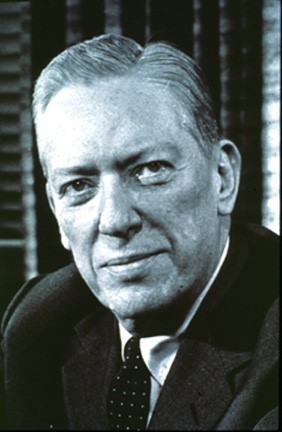 Picture of Fairfax Cone
Picture of Fairfax Cone
Fairfax M. Cone -- Wikipedia page
Fairfax Cone inherited a great advertising agency from Albert Lasker. Together with his associates, Emerson Foote, and Don Belding and their successors, Cone led that agency through more than thirty years of growth and change, preserving the agency's greatness while giving it a new type of stature and keeping the headquarters in Chicago. Cone's leadership began during a period when the advertising industry was subject to intense public criticism. Along with Leo Burnett, Bruce Barton and a small group of others, Cone led the industry's efforts to achieve social responsible self-regulation.
A. Search for a Meaningful Career
Fairfax Cone was raised in a prosperous middle class California university community. His interests in high school were in art, and he intended to become an illustrator. Cone entered the
University of California at Berkeley in 1921. His love for drawing, caused him to not spend enough time focused on his studies. He failed to pass the required courses and was sent home. When he returned, Fairfax Cone discovered literature. He concentrated on his studies and decided to become an English professor.
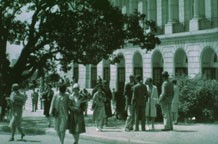 Picture
Picture
 Logo-San
Logo-San
Upon graduation, he was invited to become a teaching fellow in the English department, only to discover he had not completed a require physical education course. A disagreement over the course persisted until 1947. By this time, he had accepted a position with the San Francisco Examiner as an advertising clerk. After eight months his supervisor suggested that Cone apply for a position in the Promotions Department where he could use his artistic talent. Fairfax Cone got the job and under the direction of Truman Bailey, he began to learn same basic principles.
In 1928, Cone left the Examiner and went to work for the L. H. Waldron advertising agency in San Francisco. A year later he joined the San Francisco office of Lord and Thomas, one of the largest advertising agencies in the nation. Lord and Thomas wanted to employ Cone as an artist, but Cone insisted on being given a chance at copy writing and he was granted the opportunity.
B. Early Years at Lord and Thomas
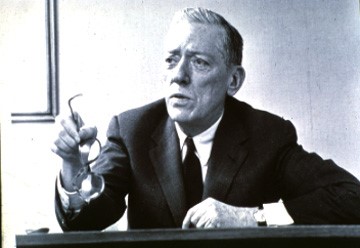 Picture
Picture
Cone was a natural and gifted writer. He quickly learned that advertising "is the language of business that is used to tell someone something of importance." From Truman Bailey he learned advertising "is a matter of being as direct and as simple as you can, of honest promises explained sensibly." During his early years at Lord and Thomas, Cone met and worked with Fred Ludekens, an artist. Together they developed five principles that guided Fairfax Cone for the rest of his career.
--The ad must make clear the basic business proposition.
--The basic proposition must express a well defined value.
--The value of the offering must be expressed in personal terms.
--The ad must express the personality of the advertiser.
--The ad must demand action.
Cone's work at Lord and Thomas caught the attention of many advertising agencies in the country. One of these was J. Stirling Getchell, Inc., Cone accepted an offer to join them in New York. Unfortunately, while enroute to New York he became ill and for the most part of the next ten years he was plagued by a mysterious illness, later diagnosed as an overactive pancreas. Soon he resigned from J. Stirling Getchell, Inc. for health reasons and returned to Lord and Thomas in San Francisco for a more hospitable climate.
C. Rise to the Ranks of Management
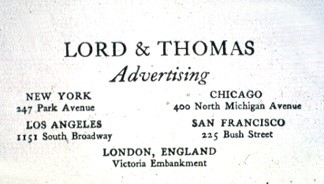 Lord
Lord
In 1939, Cone became the manager of the Lord and Thomas San Francisco office. Despite losing a major coffee company client, Cone managed to obtain the Sunmaid Raisin account, part of Safeway Stores, and others which brought him recognition from Albert Lasker, the owner of Lord and Thomas. Although Cone worked for Lord and Thomas, he did not meet Albert Lasker until March 1941. Impressed with the potential in Cone, Lasker began to attempt to persuade Cone to move to the New York office. Cone moved to New York in December 1941, where he was assigned to work directly with George Hill, who was head of the American Tobacco Company Lucky Strike campaign, a very significant account for Lord and Thomas. In 1942, Cone moved to the Chicago office of Lord and Thomas, and was placed in charge of the new Frigidaire account. Lasker appointed Cone as manager of the Chicago office in October.
D. Beginning of Foote, Cone and Belding
Lasker decided to retire from Lord and Thomas in December 1941. He planned to liquidate Lord and Thomas but hoped Fairfax Cone of the Chicago office, Emerson Foote of the New York office and Don Belding in California would continue the business under the name "Foote, Cone and Belding". Lasker solicited Lord and Thomas clients to continue with the new company, in which all but one did. Thus on December 29, 1942 Foote, Cone and Belding was born.
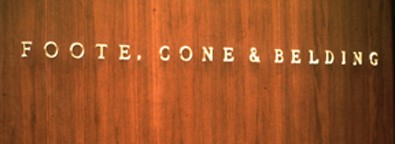 Picture
Picture
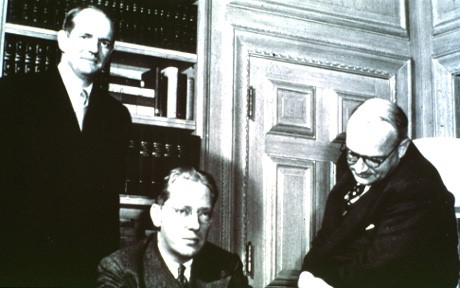 Picture of Foote, Cone & Belding
Picture of Foote, Cone & Belding
The three men were devoted to running an ethical, professional and socially responsible company, regardless of the consequences. For a decade, Fairfax Cone, chairman of the Executive Committee, Don Belding, Chairman of the Board, and Emerson Foote, President, ran the agency as a team. In 1952 poor health caused Foote to retire and Belding retired in 1959 at the age of 60, to devote most of his time to public affairs. Although new men replaced Foote and Belding, Cone continued to be the "leader amoung leaders" in the management of Foote, Cone and Belding, where he served on the Board of Directors until 1975.
Cone's amazing longevity in the business can be attributed to his interest and concern with the "professionalization" of advertising, the sheer pleasure he derived from the act of product presentations and the fact that shortly after the establishment of Foote, Cone and Belding, Albert Lasker discovered a doctor who had devised a simple, effective treatment for Cone's illness.
E. Product Presentation
During the years of Cone's leadership, Foote, Cone and Belding held its position as one of the largest ten advertising firms in the country for more than 30 years. Cone endowed the business with a certain dignity and professionalism that made it an excellent model of how a socially responsible advertising agency should behave.
Fairfax Cone's favorite part of the advertising business was product presentation and throughout his decades of agency leadership he kept himself actively engaged in developing new advertising campaigns.
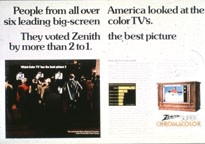 Picture of Zenith Advertisement
Picture of Zenith Advertisement
Some of the accounts Cone was actively involved in were: Toni home permanent kit, Armour, "Dial" soap, Hallmark Cards, Kool-Aid, Good Seasons Salad Dressings, Klear, Raid, Clairol hair coloring, Zenith television, Dole Pineapple, Contac cold relief medicine, Sunbeam shavers, the Edsel and Sara Lee baked goods. In each of these accounts Cone was involved in heading the team that developed the advertising campaign.
F. Making Advertising Respectable
Shortly after Foote, Cone and Belding was established in 1942 an event occurred that jeopardized the advertising industry and created the need for industry statesmanship that was partially filled by Fairfax Cone. A sensational novel " The Hucksters" was published that portrayed advertising as a deceitful and degrading vocation. The book was followed by a motion picture in 1946. Most advertising agencies were angered as they considered this an unjust attack on their business, but only a few resolved to do anything about the image of the advertising industry.
Fairfax Cone was one of those individuals and his efforts to improve advertising's reputation during the next quarter century became one of his greatest contributions to the industry. Cone became a significant participant in the Advertising Council.
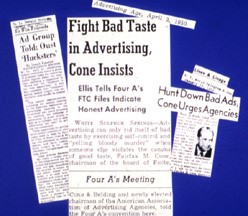 Newspaper
Newspaper
Cone became the director of the American Association of Advertising Agencies in 1946. Through his leadership this group attempted to make advertising more respected. During this time Cone wrote a great deal on the subject of advertising and it's respectability. He wrote about what was right and wrong with advertising and how it should be corrected or stressed; and he wrote about the obligations of the industry leaders to strive for increased professionalism.
Cone practiced his "Professionalism" beliefs in his own business life. Through his example he helped an important industry make itself socially responsible and respectable.
Conclusion
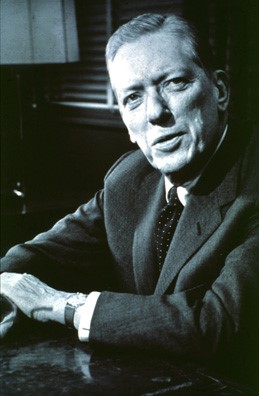
Picture
Fairfax Cone was a natural and gifted artist and writer who was able to develop unique advertising campaigns. His abilities were noticed by Albert Lasker, owner of Lord and Thomas, in 1941. Lord and Thomas was dissolved in 1942 and "Foote, Cone and Belding" was established The three new owners were committed to running an ethical, professional and socially responsible company, regardless of the consequences. Cone's professionalism prevailed throughout Foote, Cone and Belding. His favorite part of advertising was product presentations and he was an active member in the development of many campaigns. In addition, his activities in the American Association of Advertising Agencies contributed to the establishment of advertising as a professional vocation and a respectable industry.
Copyright 2001 American National Business Hall of Fame. All Rights Reserved.










